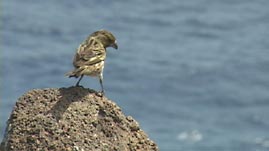Teachers' Domain - Digital Media for the Classroom and Professional Development
User: Preview

Source: The Bishop Museum, Honolulu, Hawaii
In this video segment adapted from the NOW-RAMP 2002 Expedition, explore some of the features and unique organisms found on Nihoa Island, a tiny island in the Hawaiian Archipelago. Learn why islands such as Nihoa not only provide a laboratory in which unique species can be studied, but have also proven to be fragile ecosystems that require careful protection.
The Hawaiian Islands are ripe for the evolution of new species—or at least they were, not long after they burst from a volcanic hot spot in the floor of the Pacific Ocean. Several million years ago, Nihoa Island and some of the other old islands in the northwestern part of the chain were newborns. Barren rock, they provided a clean slate and fresh opportunities to any organism lucky enough to drift or be blown ashore, as long as it could survive and reproduce.
New species can evolve just about anywhere given the right opportunities. However, islands provide a unique set of circumstances that make the process by which new species evolve, also known as speciation, a likely outcome. New islands in particular present a set of unexploited opportunities and novel selective pressures to founding populations, and this is perhaps the most important factor in speciation. With opportunity and pressure comes change through natural selection, and this change ultimately gives rise to diversity.
Isolation is another important factor in island speciation. A regular influx of individuals and genes from a mainland population would slow or prevent the founding population from diverging from the original group. Isolation prevents the parent population from diluting the founding population's genes, and as a result, divergence can proceed as natural selection dictates.
The larger and more varied an environment is, the more opportunities, or ecological niches, it provides to founding populations. The level of complexity in an environment corresponds roughly to the number of species that might ultimately result. One striking example occurred on some of Hawai`i's largest islands. A single bird species suspected of colonizing Hawai`i approximately five million years ago ultimately diverged into 57 different species. Many of these birds, collectively called honeycreepers, look and behave nothing like other species in the group. Their diversity illustrates the power of evolution given opportunity and isolation.
Nihoa Island's two endemic species followed paths similar to those of the honeycreepers. Through natural selection, the founding population or populations changed, and ultimately diverged, to become species distinct from those found anywhere else in the world. However, because Nihoa Island was never more than about one square kilometer in area, there was limited opportunity for divergence, and speciation gave rise to only two species, rather than dozens.
Today, these species are threatened by the introduction of invasive species from other parts of the world. Exotic species could potentially prey on the native species or compete with them for food or other resources. Given this threat, conservation workers strive to eliminate exotics from this and other sensitive ecosystems whenever they're found.
 Loading Standards
Loading Standards Teachers' Domain is proud to be a Pathways portal to the National Science Digital Library.
Teachers' Domain is proud to be a Pathways portal to the National Science Digital Library.
